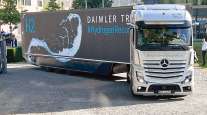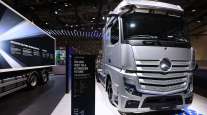Senior Reporter
60-Year-Old Daimler Plant Is Ready for the Future
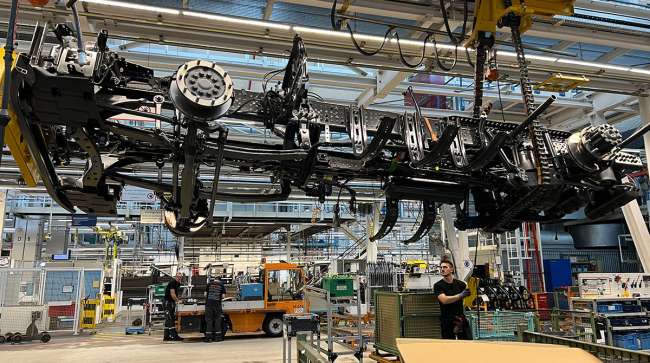
[Stay on top of transportation news: Get TTNews in your inbox.]
WÖRTH AM RHEIN, Germany — For 60 years, a Daimler Truck factory that sits along the Rhine River in Germany’s Southern Palatinate region has been producing models sold under the Germany-based manufacturer’s Mercedes-Benz brand. It’s one of the largest vehicle assembly facilities in the world, and every unit that passes through its doors is proudly called a “Wörther” by the workers.
As the facility marks six decades of producing commercial vehicles, it and manufacturing sites around the globe sit poised for reinvention amid sweeping change in how commercial trucks are built, used and powered.
Officials at this plant said they’re ready.
“It’s such a great feeling to come together to celebrate this event of 60 years and knowing that production is running at full steam,” said Andreas Bachhofer, Wörth plant manager and head of production for European truck assembly, in an interview with Transport Topics that covered the plant’s past, and its future. “It is really superb.”
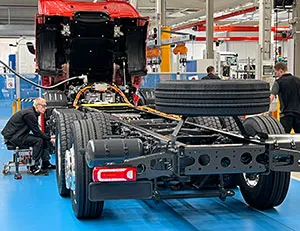
Trucks manufactured at Wörth have pulled duty in more than 150 nations. (Dan Ronan/Transport Topics)
Bachhofer has led the team at Wörth for more than two years but has been with Daimler nearly 30 years, joining in 1995 while still in college.
The plant, which can produce up to 470 trucks per day, collectively with its associated test facilities covers the space of more than 400 soccer fields — one soccer field stretches 115 yards — and its 10,000-plus workers and support staff have produced hundreds of thousands of diesel-powered trucks. With the industry on the cusp of what could be a challenging, expensive and long-term transition to newer fuels, such as hydrogen and battery-electric, Bachhofer said he believes the facility will have the financial resources and trained labor pool to smoothly make that move.
“We’ve never been in a period of more change than we are now,” he said. “We are decarbonizing our products, going to electric and going to fuel cells and also decarbonizing our production side, going for green electricity and finding ways to produce the heat for our plant in a carbon-neutral way.”
Since the plant has been in operation, trucks manufactured at Wörth have pulled duty in more than 150 nations. Bachhofer believes this plant and the others he manages across Europe are poised for a long-term transition that will deliver a variety of commercial vehicles to customers.
“We will have this transition for a very long time,” he said, “and the intent was, with the research and development team, to make sure that we can use this facility to not only build diesel trucks but also electric trucks. And we are finding ways to keep the basic rigid backbone of the truck in the same way — like we do now with the diesel truck — and integrate the electric trucks into that.”
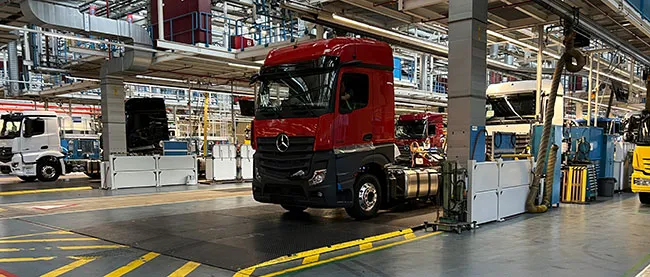
Trucks roll off the assembly lines. (Dan Ronan/Transport Topics)
He added, “[With] these electric drivetrains, the energy [coming] from a battery is one option, or from a fuel cell. That is the basic idea — to bring the new drivetrain into the vehicles.”
Many of the plant’s 8,000 assembly line workers have been with the company for 30-plus years, and it is not uncommon to find second- and third-generation employees building trucks. Daimler believes this experienced workforce allows for them to customize an individual truck to a customer’s specifications with a minimum of disruption. There also is an extensive research and development team at the plant, along with a group of testers who run trucks on a test track after they are built to see if any flaws in the manufacturing process crop up.
To the end user, Bachhofer said one of the keys in developing electric trucks is ensuring they look and feel like their diesel counterparts.
“When you remove the engine and transmission, we are using that space,” he said. “We can integrate the components for an electric truck, such as the cooling system and low-voltage system, into that space into the front box. We can run an electric drivetrain on the same assembly line, and we do not have a huge difference in time assembling a diesel truck or an electric vehicle.”
Bachhofer said the plan over the next several years is to develop parallel assembly lines building both diesel and fuel cell electric trucks using cross-trained workers. “We have a highly trained workforce and team,” he said.
Daimler has partnered with Volvo Group on an initiative called Cellcentric to develop hydrogen fuel cell technology. In late September, Daimler showcased its hydrogen-powered, zero-emission, longhaul Mercedes-Benz GenH2 Class 8 truck. Built at the Wörth plant, the truck completed a 650-mile run along Germany’s highway system nearly from Wörth to Berlin on a single fueling of liquid hydrogen.
We’ve made it! After more than 1,000 km, our #MercedesBenz #GenH2 Truck has successfully completed its record run – on a single fill of liquid hydrogen! #HydrogenRecordRun🚛🏅#MovingForward #FuelCellTruck #HydrogenTruck #FuelCell #Sustainability #FutureMoves pic.twitter.com/BYQMNYIa6k — Daimler Truck AG (@DaimlerTruck) September 26, 2023
The truck is powered by a hydrogen fuel cell that produces electricity, which provides battery power that drives the truck’s electric axles.
Cellcentric CEO and former Wörth plant General Manager Matthias Jurytko was proud of that demonstration run, and believes alternative fuels such as hydrogen will play a significant role in the company’s truck development future.
“It was breathtaking,” he said of the GenH2 highway run. “It makes me proud of the technology and the people who have developed it. All these years it took to accomplish it.”
Longer-term, he acknowledges the challenges that lie ahead, but says the challenges facing the global trucking industry are compelling the shift.
“To switch from fossil propulsion technology to zero-emission trucks, you need to look at the total cost of ownership,” he said. “Yes, the initial cost for hydrogen is higher than a diesel engine, but you have to look at this over five years. Right now, we are not factoring in the cost of the diesel [or] carbon usage compared to a carbon-neutral system. This is a business case.”
Want more news? Listen to today's daily briefing below or go here for more info:


